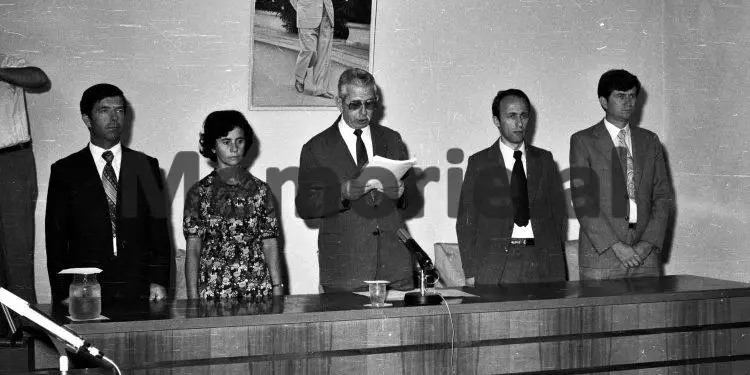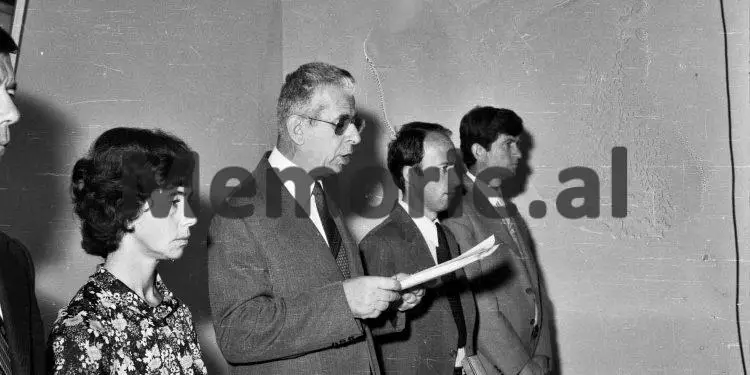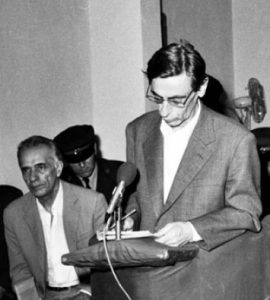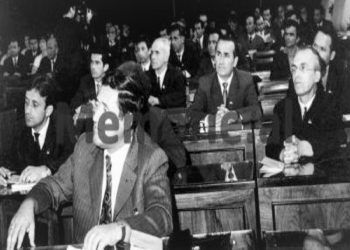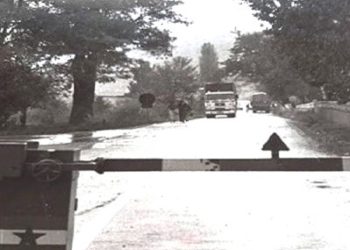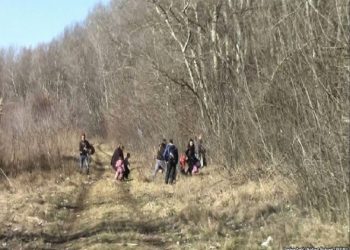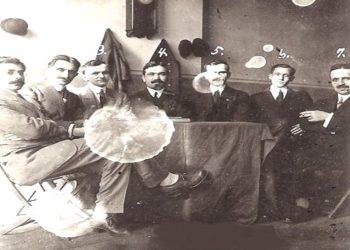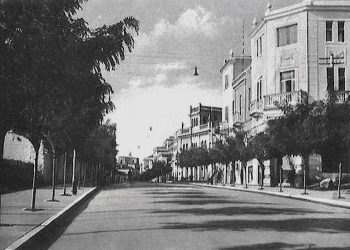Dashnor Kaloçi
Memorie.al publishes some unknown photos that have not been made public, which show us some rare images dating back to September 1983, taken in one of the main courtrooms of the Tirana High Court, where the court headed by Aranit Cela, is making the decision on former Health Minister Llambi Zicishti, the wife of former Prime Minister Mehmet Shehu, Fiqret, her son, Skender, and former Foreign Minister Nesti Nase. They were part of the so-called “hostile group of Mehmet Shehu and Kadri Hazbi” who were then accused of: “collaborating with foreign agents such as the American CIA, the Yugoslav UDB, etc., with the aim of poisoned Comrade Enver Hoxha, First Secretary of the Central Committee of the ASP”.
In the early days of September 1983, after nearly a year of investigative proceedings in the Special Investigations premises at the “Ward 313”, as it was known as the “Old Prison” of Tirana, investigations into the so-called “hostile agent group” was completed. of Mehmet Shehu ”, headed by Kadri Hazbiu, a former Minister of Defense and a member of the Political Bureau of the Central Committee of the ASP, (who also held the position of Minister of Internal Affairs, Nesti Nase, for 27 years of Foreign Affairs, Feçor Shehu, former Minister of Internal Affairs and Director of State Security for many years, Lambi Ziçishti, former Minister of Health, Mihallaq Ziçishti, former Deputy Minister of Internal Affairs, Fiqret Shehu, wife of former Prime Minister Mehmet Shehu and former Principal of the Vladimir Ilien Lenin Party High School in Tirana, as well as Lambi Pecini, former Principal Gani Kodra, a former senior State Security officer and for several years with former Prime Minister Mehmet Shehu, Ali, was also tried alongside this “group”. Cheno, commander of the escorting group of former Prime Minister Mehmet Shehu, Xhavit Ismailaga, a barber by profession at Hotel “Dajti”, as well as Skender and Bashkim Shehu, two sons of former Prime Minister Mehmet Shehu.
The whole investigation process of this “hostile group”, which lasted about a year, was conducted according to the directions and notes are given by Enver Hoxha, writing with his own hand the relevant questions that some of the key leaders had to ask the investigators. of that group, e.g. Figs of Shehu, etc. They were kept under strict security measures at the “Ward 313” in Tirana, where, except for some internal guards (civilians, police, and military), they were kept in cells and in the corridors of the prison where they were detained. chained to head and toe with chainsaws, Kadri Hazbiu, Feçor Shehu, Nesti Nase, Llambi Ziçishti, Llambi Pecini, Fiqret Shehu, etc.
At the conclusion of the investigative and judicial process against this so-called “Mehmet Shehu’s hostile group”, the High Court Panel, headed by Aran Çela (president of that court), and the Prosecutor General, Rrapi Mino, made the relevant decisions. each of the defendants, where although the charges against them were almost the same, this “hostile group” was divided and tried in two separate groups ?! The first group included Kadri Hazbiu, Feçorr Shehu, Mihallq Ziçishti, Llambi Pecini, Ali Ceno and Gani Kodra, (who had military functions), while the second group included: Llambi Ziçishti, Fiqret Shehu, Nesti Nase , Xhavit Ismailaga and Skender, and Bashkim Shehu, who had non-military functions and duties. Their split was made “because in the first group headed by Kadri Kazbiu, former senior officials who held military posts and positions were not tried and no military and state secrets were to be revealed”.
The trial of these two groups took place at the premises of the “Old Prison 313” of the Old Prison of Tirana (or as it was known by the convicts as “Kaushi”), and only the decision of their sentences by the Special Panel of the Court was given in the premises of the High Court, where only the first trial of them took place in the beginning of August 1983, and all other hearings took place in the premises of that prison. Which was done “for security reasons”, since “while transporting that hostile group from ‘Ward 313’ to the Supreme Court premises and vice versa, foreign intelligence and their agents could hijack them”? ! This was said to be unintentionally propagated by the State Security, and certain other segments, to create in the people an image and conviction of the “importance and danger posed by that hostile group”.
While photos with images of the “hostile group”, which included Kadri Hazbiu, Feçor Shehu, Llambi Pecini, Mihallaq Zicishti, Ali Ceno, and Gani Kodra, both in court and at sentencing, are now known as having long been publicized, Memorie.al is publishing some unknown photos that show us the verdicts of sentencing the “second hostile group”, which included: Llambi Zicishti, Nesti Nase, Fiqret Shehu, Xhavit Ismailaga and Skender and Bashkim Shehu.
As can be seen in the photos in question, which took place on August 30, 1983, in one of the courtrooms of the Tirana High Court, in addition to the High Court Panel presided over by Aranit Çela, which is fixed between the members of the Supreme Court. others of that panel, (reading the panel’s verdict on the convictions of that “hostile group”), in two other photos, look at the defendant, Llambi Zicishti (second from the right in the first line), who is in between the two police officers and Fiqret Shehu, (yes in the front row, second from the left) who looks between the two police officers who provide him.
Behind them, in the second row, are former Minister of Foreign Affairs Nesti Nase (in black glasses) and Skender Shehu, (second son of Mehmet and Fiqret Shehu), as well as officers, and police sub-officers of security of “Ward 313”, and members of the “Special Investigator” of the investigative team that dealt with that process, as well as various guests with special summonses assisted during that trial, most of whom were from the Ministry of Labor. Interior and State Security.
As it is already known, after Kadri Hazbiu, Feçor Shehu and Llambi Peqini, from the first group who were sentenced to death, executed by the Special Panel of the High Court in the decision given to them on September 1, 1983, by the second group , was sentenced to death by firing only former Health Minister, Llambi Zicishti, who appears in the photo in question. Fiqrete Shehu, Nesti Nase, Ali Ceno, Xhavit Ismailaga, Skender and Bashkim Shehu were sentenced to 25 to 15 years in prison.
Whereas for the former senior executives of the Ministry of Internal Affairs starting from Kadri Hazbiu, Feçor Shehu, Mihallaq Ziçishti, Llambi Peqini, etc., there was no doubt about the reasons why they were eliminated by Enver Hoxha, otherwise, it happened with Llambi Zicishti, since then, until today, has remained shrouded in mystery and various versions and hypotheses have been circulated to eliminate it. Zicishti, originally educated in Paris and then in Bucharest, (as little as anyone at the time), was one of the most educated of all the ministers of the Albanian government, and his firing sentence caused little surprise at that time, as his brother Mihallaqi, one of the top leaders of the Ministry of Internal Affairs for years who had headed the State Security, was also expected to be sentenced to death. Regarding his physical elimination, after the 1990s he was said to have been executed after going to Mehmet Shehu’s house on the morning of January 18, 1981, when he was found shot to death, saying: “This is murder. classic “?! But this thing that has been circulated only as a hypothesis seems to have been “blown away” a few months ago when the well-known doctor’s book, Dr. Prof. Isuf Kalo, who writes in his memoirs: Enver has refused to meet Ziçishti since the summer of 1981 when he went to see Enver’s health when he was at his villa on the Vlora coast. So, which clearly demonstrates and the teaching, that: Enver had previously planned the physical elimination of Zicishti, making him a close associate of Mehmet Shehu and accusing them both of: “affiliated with foreign agents, had wanted to poison the First Secretary of the Central Committee of the ASP. ”
The execution order for Kadri Hazbiu, Feçor Shehu, Llambi Ziçishti and Llambi Peqini was enforced on September 10, 1983, where, at midnight, under strict security measures, the four convicts were taken and sent somewhere on the outskirts of Tirana near the village of Linza, where they were executed at the appointed place after previously the Attorney General communicated the decision of the Presidium of the People’s Assembly, which had not accepted their requests for the pardon of life and demanded from them the last words that a record was kept of all those who assisted in their execution were signed.
Memorie.al




